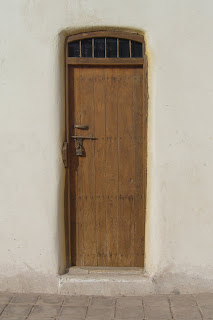 Since it could possibly be one of the sites for the community college, today we went to Al Jahra, an oasis town that used to be agricultural and is located about 20 miles northwest from Kuwait City and 75 miles from the Iraq border.
Since it could possibly be one of the sites for the community college, today we went to Al Jahra, an oasis town that used to be agricultural and is located about 20 miles northwest from Kuwait City and 75 miles from the Iraq border. On the way there we saw this multipurpose stadium; it looks like a flying saucer.
On the way there we saw this multipurpose stadium; it looks like a flying saucer. And we saw more mosques than in Kuwait City.
And we saw more mosques than in Kuwait City.


 Once in the town we noticed that there were many more covered women than in the city.
Once in the town we noticed that there were many more covered women than in the city.


 Water tanks are stacked on top of many buildings.
Water tanks are stacked on top of many buildings. 
We visited the Al Qasr Al-Ahmar, that is, the Red Palace fort.
 The Red Palace fort was ordered to be constructed in the early 1900s by the Amir, Sheikh Mubarak Al-Sabah, who is known today as Mubarak Al-Kabir (Mubarak the Great).
The Red Palace fort was ordered to be constructed in the early 1900s by the Amir, Sheikh Mubarak Al-Sabah, who is known today as Mubarak Al-Kabir (Mubarak the Great). It was to be used primarily as a strategically located fort that would protect the agricultural village of Jahra from invasion.
It was to be used primarily as a strategically located fort that would protect the agricultural village of Jahra from invasion.  On October 10, 1920, Jahra was attacked by an army which was led by Faisal Al-Daweesh of Saudi Arabia. Four hundred Saudi men took over Al Jahra.
On October 10, 1920, Jahra was attacked by an army which was led by Faisal Al-Daweesh of Saudi Arabia. Four hundred Saudi men took over Al Jahra. Amir Sheikh Salem Al-Mubarak Al-Sabah (the son of Mubarak the Great who built the fort) led about 2,000 Kuwaiti fighters in the battle.
Amir Sheikh Salem Al-Mubarak Al-Sabah (the son of Mubarak the Great who built the fort) led about 2,000 Kuwaiti fighters in the battle. On October 11, Sheikh Ahmad, who had been safeguarding Kuwait City, sent another 600 armed fighters on boats to help those besieged at the Red Palace.
On October 11, Sheikh Ahmad, who had been safeguarding Kuwait City, sent another 600 armed fighters on boats to help those besieged at the Red Palace. There was a battle and Al-Daweesh and his men left Al Jahra.
There was a battle and Al-Daweesh and his men left Al Jahra. Today, the Red Palace is a source of pride in that it symbolizes patriotism and fortitude; it is one of the few things that made it intactly through the destruction of the invasion in 1990.
Today, the Red Palace is a source of pride in that it symbolizes patriotism and fortitude; it is one of the few things that made it intactly through the destruction of the invasion in 1990. 
******************************************************************
The WVMCCD-Kuwait team:
John, Phil, Raj, Stan, Dulce Maria, Cindy, Lance
 Our week of work is winding down; after a break we'll return to campus and continue to plan for this productive venture with our partner in Kuwait. Although I will continue to blog about my own travels through Tunisia and Italy, this is the last posting I'll make about our work here in Kuwait. Thank you for reading and for sharing our excitement.
Our week of work is winding down; after a break we'll return to campus and continue to plan for this productive venture with our partner in Kuwait. Although I will continue to blog about my own travels through Tunisia and Italy, this is the last posting I'll make about our work here in Kuwait. Thank you for reading and for sharing our excitement. 


































